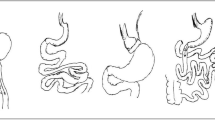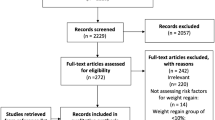Abstract
Introduction
There is a need for a standardized, evidence-based classification of post-bariatric weight-regain, to investigate and compare revision procedures and to advice and treat patients in an evidence-based way.
Methods
We used standard deviations (SD) of the highest (1–2 years) and latest (> 2 years) percentage total weight loss (%TWL) results after primary bariatric surgery from the Dutch Audit for Treatment of Obesity (DATO) bariatric registry as benchmarks for (above) average (≥ − 1SD), poor (− 1SD to − 2SD) and insufficient (< − 2SD) weight loss. Weight regain maintaining (above) average weight loss was called grade 1, weight regain towards poor weight loss grade 2, towards insufficient weight loss grade 3, with subgrades 2a/3a for below average weight loss from the start, and 2b/3b for weight regain from (above) average to below average weight loss. Patient characteristics and diabetes improvement/impairment were compared. Sensitivity and specificity of 14 existing weight regain criteria were calculated.
Results
We analyzed 93,465 results from 38,830 patients (77.1% gastric bypass, 22.5% sleeve gastrectomy). The − 1SD thresholds for early and late weight loss approximated 25%TWL and 20%TWL, the − 2SD threshold for late weight loss 10%TWL. Weight regain could be analyzed for 18,403 patients (2.5–5.2 years follow-up). They regained mean 6.7 kg (5.4%TWL), with 66.8% grade 1 weight regain, 7.2% grade 2a, 7.4% grade 2b, 2.1% grade 3a, and 0.6% grade 3b. There were significant differences in comorbidities, gender, age, weight regain, diabetes impairment, and diabetes improvement across grades. Weight regain criteria from literature were extremely divers. None had high sensitivity.
Conclusion
The DATO classification for post-bariatric weight regain combines the extent of weight regain with evidence-based endpoints of weight loss. It differentiated weight regain maintaining (above) average weight loss, two intermediate grades, gradual weight regain with below average weight loss from the start (primary non-response) and steep weight regain towards insufficient weight loss (secondary non-response). The classification is superior to existing criteria and well supported by evidence.
Graphical Abstract





Similar content being viewed by others
References
Franken RJ, Sluiter NR, Franken J, et al. Treatment options for weight-regain or insufficient weight-loss after sleeve gastrectomy: a systematic review and meta-analysis. Obes Surg. 2022;32(6):2035–46.
King WC, Hinerman AS, Courcoulas AP. Weight-regain after bariatric surgery: a systematic literature review and comparison across studies using a large reference sample. Surg Obes Relat Dis. 2020;16(8):1133–44.
Majid SF, Davis MJ, Ajmal S, et al. Current state of the definition and terminology related to weight recurrence after metabolic surgery: review by the POWER Task Force of the American Society for Metabolic and Bariatric Surgery. Surg Obes Relat Dis. 2022;18(7):957–63.
Van de Laar AW, Acherman YI. Weight-loss percentile charts of large representative series: a benchmark defining sufficient weight-loss challenging current criteria for success of bariatric surgery. Obes Surg. 2014;24:727–34.
Van de Laar AW, Van Rijswijk AS, Kakar H, Bruin SC. Sensitivity and specificity of 50% excess weight-loss (50%EWL) and twelve other bariatric criteria for weight-loss success. Obes Surg. 2018;28:2297–304.
Van de Laar AW, Nienhuijs SW, Apers JA, van Rijswijk AS, de Zoete JP, Gadiot RP. The Dutch bariatric weight-loss chart: a multicenter tool to assess weight outcome up to 7 years after sleeve gastrectomy and laparoscopic Roux-en-Y gastric bypass. Surg Obes Relat Dis. 2019;15(2):200–10.
Tan SYT, Syn NL, Lin DJ, et al. Centile charts for monitoring of weight-loss trajectories after bariatric surgery in Asian patients. Obes Surg. 2021;31(11):4781–9.
Mor A, Sharp L, Portenier D, Sudan R, Torquati A. Weight-loss at first postoperative visit predicts long-term outcome of Roux-en-Y gastric bypass using Duke weight-loss surgery chart. Surg Obes Relat Dis. 2012;8(5):556–60.
Poelemeijer YQM, Liem RSL, Nienhuijs SW. A Dutch Nationwide Bariatric Quality Registry: DATO. Obes Surg. 2018;28(6):1602–10.
Courcoulas AP, King WC, Belle SH, et al. Seven-year weight trajectories and health outcomes in the longitudinal assessment of bariatric surgery (labs) study. JAMA Surg. 2017;153:427–34.
Voorwinde V, Hoekstra T, Monpellier VM, Steenhuis IHM, Janssen IMC, van Stralen MM. Five-year weight-loss, physical activity, and eating style trajectories after bariatric surgery. Surg Obes Relat Dis. 2022;18(7):911–8.
Sjöström L, Narbro K, Sjöström CD, et al. Swedish obese subjects study. Effects of bariatric surgery on mortality in Swedish obese subjects. N Engl J Med. 2007;357(8):741–52.
van de Laar AW, de Brauw M, Bruin SC, Acherman YI. Weight-independent percentile chart of 2880 gastric bypass patients: a new look at bariatric weight-loss results. Obes Surg. 2016;26(12):2891–8.
Uittenbogaart M, de Witte E, Romeijn MM, et al. Primary and secondary nonresponse following bariatric surgery: a survey study in current bariatric practice in the Netherlands and Belgium. Obes Surg. 2020;30(9):3394–401.
van de Laar AW, Emous M, Hazebroek EJ, Boerma EJ, Faneyte IF, Nienhuijs SW. Reporting weight-loss 2021: position statement of the Dutch Society for Metabolic and Bariatric Surgery (DSMBS). Obes Surg. 2021;31(10):4607–11.
Voorwinde V, Steenhuis IH, Janssen IM, et al. Definitions of long-term weight-regain and their associations with clinical outcome. Obes Surg. 2020;30(2):527–36.
Deitel M, Gawdat K, Melissas J. Reporting weight-loss 2007. Obes Surg. 2007;17(5):565–8.
Livhits M, Mercado C, Yermilov I, et al. Preoperative predictors of weight-loss following bariatric surgery: systematic review. Obes Surg. 2012;22(1):70–89.
Adams ST, Salhab M, Hussain ZI, Miller GV, Leveson SH. Roux-en-Y gastric bypass for morbid obesity: what are the preoperative predictors of weight-loss? Postgrad Med J. 2013;89(1053):411–6.
Wood GC, Benotti PN, Lee CJ, et al. Evaluation of the association between preoperative clinical factors and long-term weight-loss after Roux-en-Y gastric bypass. JAMA Surg. 2016;151(11):1056–62.
Kitamura R, Chen R, Trickey A, Eisenberg D. Positive and negative independent predictive factors of weight-loss after bariatric surgery in a veteran population. Obes Surg. 2020;30(6):2124–30.
Acknowledgements
We thank the members of the Dutch Audit for Treatment of Obesity Research Group, G van Acker, J Apers, F Berends, M de Brauw, S de Castro, S Damen, A Demirkiran, I Faneyte, J Greve, E Hazebroek, G van ’t Hof, E Jutte, R Klaassen, E Lagae, B Langenhoff, R Liem, A Luijten, S Nienhuijs, R Smeenk, S Smeets, W Vening, and M Wiezer. The authors thank all administrative nurses, paramedic staff, registrars and medical specialists who registered patients and outcome in the Dutch Audit for Treatment of Obesity.
Author information
Authors and Affiliations
Consortia
Corresponding author
Ethics declarations
Competing Interests
The authors declare no competing interests.
Additional information
Publisher's Note
Springer Nature remains neutral with regard to jurisdictional claims in published maps and institutional affiliations.
Key points
• We present a weight regain grading system based on benchmark data (weight loss and change of diabetes) from the large Dutch Audit for Treatment of Obesity (DATO) national bariatric registry.
• The classification combines the extent of weight regain with endpoints of weight loss, differentiating gradual, steep, intermediate, and problematic grades of weight regain.
• Existing criteria and thresholds for weight regain in literature are extremely divers in definition and impact and all have low sensitivities.
Rights and permissions
Springer Nature or its licensor (e.g. a society or other partner) holds exclusive rights to this article under a publishing agreement with the author(s) or other rightsholder(s); author self-archiving of the accepted manuscript version of this article is solely governed by the terms of such publishing agreement and applicable law.
About this article
Cite this article
Franken, R.J., de Laar, A.W.V. & Dutch Audit for Treatment of Obesity Research Group. Evidence-Based Classification for Post-bariatric Weight Regain from a Benchmark Registry Cohort of 18,403 Patients and Comparison with Current Criteria. OBES SURG 33, 2040–2048 (2023). https://doi.org/10.1007/s11695-023-06586-3
Received:
Revised:
Accepted:
Published:
Issue Date:
DOI: https://doi.org/10.1007/s11695-023-06586-3




